When I was growing up, the calls of dozens of “chirk-a-rees” floating up from the marshes a half-kilometre away were a sure signal of spring. I learned what male Red-winged Blackbirds looked like before I started school. Short-tailed European Starlings with their oil-slick colours and showy dots and long-tailed Peacock blue and purple Common Grackles also stuck in my memory. When I visited Florida I learned about Boat-tailed Grackles and when I moved to the west, I saw Yellow-head Blackbirds. But until very recently, I had never seen nor heard of Rusty Blackbirds. So when I saw postings online of sightings of these Red-winged-like birds, I wanted to try to catch a glimpse of them.
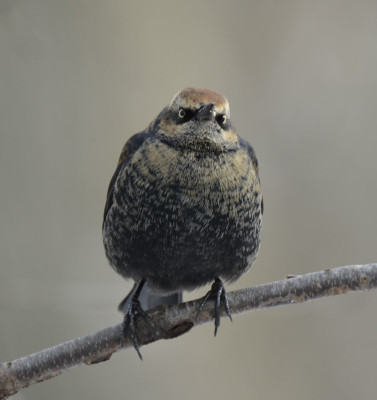
Does he look peevish or is it just me?
Why Is It So Hard to See Rusty Blackbirds In Southern Ontario?
Rusty Blackbirds are not one of those birds that we only get to see if it migrates in the wrong direction, or gets blown out of its range by a storm, like a Brant Goose or a Harris Sparrow. In fact, fifty years ago, Rusty Blackbirds were quite common throughout North America. For some unknown reason, however, their population has plummeted over the last 40 years, according to various sources including the Cornell University website. No totally satisfactory explanation has been found.
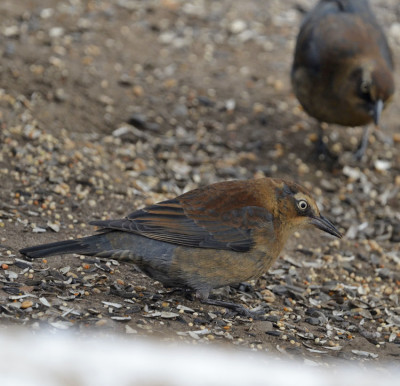
A female Rusty Blackbird; Females are more tan coloured on the front underside than the males.
These birds normally nest in northern Canada and Alaska, migrate through southern Canada and over-winter in the mid to south-east United States.
Two Places I’ve Seen Rusty Blackbirds on Migration in Southern Ontario Near the West GTA
Rusty Blackbirds don’t normally nest in southern Ontario so my best bet to see them was during spring and fall migration.
Reports for the western end of the Greater Toronto Area, including Hamilton, led me to three spots where I’ve seen them clearly: the Rattray Marsh in Mississauga, the Royal Botanical Gardens, and one place a bit further south and west, the Ruthven Historical Property.
Like most blackbirds, these ones like farm fields and creek and pond edges, so there are lots of reports (during migration) from around Waterloo, Cambridge and Guelph for those willing to go a bit further than I can. eBird is a great resource for checking whether they are reliably seen each year at a particular spot.
Did I Notice Any Unusual Behaviour from These Uncommon Blackbirds?
Nope.
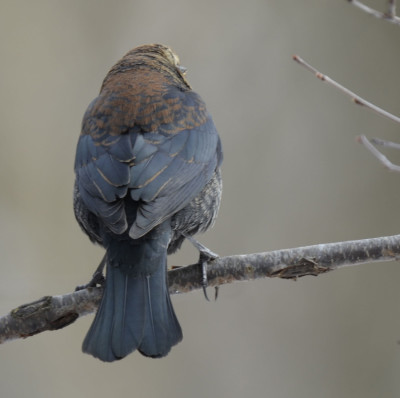
This is the view I usually get of birds.
When I saw them at the Rattray Marsh, they were hunting along the mudflats at the outlet of the lagoon. Like Grackles and Red-winged Blackbirds, they walked along the shore and poked at anything that seemed likely.
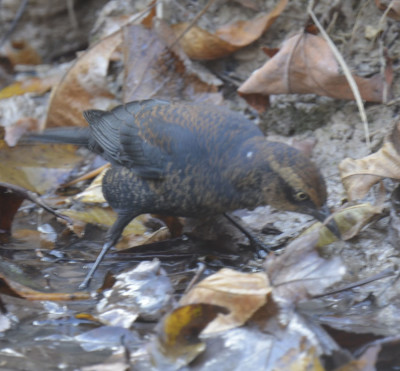
A hunting Rusty Blackbird at Ruthven.
When I saw them at Ruthven in the fall, they were also poking along the edge of the water, though this time the wet bank of a very small creek behind the historical house and bird banding station. In fact, it took me a few minutes to get a good look and make sure they weren’t Grackles. Others arrived on the Ruthven property in a large flock and landed in the tops of several bare trees. Their calls were different than those of a Red-winged Blackbird but otherwise it would have been easy to mistake them from a distance.
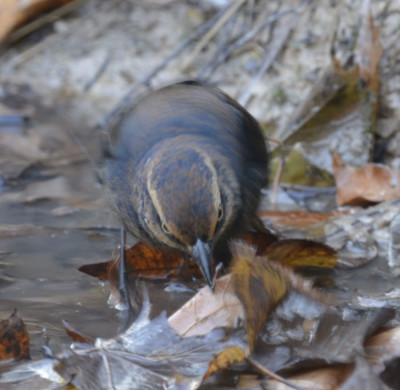 Hunting along the edge of a creek, a Rusty Blackbird at Ruthven also keeps a wary eye out for predators.
Hunting along the edge of a creek, a Rusty Blackbird at Ruthven also keeps a wary eye out for predators.
And most recently, when I saw them on the RBG grounds, they were eating mixed bird seed from the ground. On the day I was there, the nearby pond was frozen and there was a few centimetres (a bit over an inch) of fresh snow on the ground so if they did want to poke along the water’s edge they would have had a more difficult time. When startled by a squirrel, they flew up into the bare tree branches like the birds at Ruthven.
So my brief encounters with these birds didn’t offer me any profound clues into their serious population decline.
I hope that they aren’t truly on their way to extinction. In case it will help in any way the scientists studying these birds, I will continue to watch for them and report them on eBird when I find them.

In flight, the rusty head may show up clearly.
Related Reading
- Looking for Rusty Blackbirds and Tufted Titmice
- An Autumn Ramble Around the Ruthven Park National Historic Site
- A Female Red-winged Blackbird Looks a Bit Like an Over-sized Sparrow
- A Spring Ramble through the Rattray
- A Gray Catbird Mews at Lakeside Park Woods
- Black Friday Birds
Join In
Have you seen Rusty Blackbirds in your neck of the woods? Please share your sighting. (And report it on eBird!)

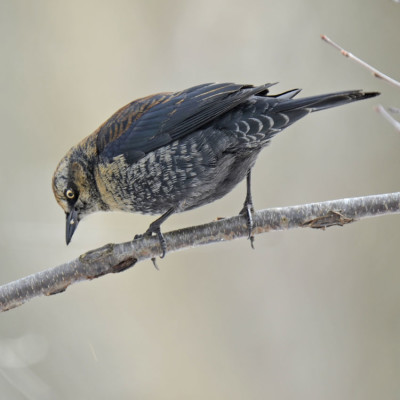
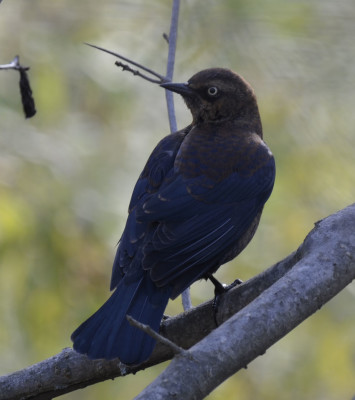
There has been a bird in our yard for the past week. It seems to be unafraid of us. It is black with spattering of brown. I’m wondering what kind of beard it is. It hangs around us. It does not appear hurt or injured in any way. It can fly. It seems to be almost tame to some degree. I will take a picture of it tomorrow.
It sounds like it may be a bird that hatched this year–they are often almost “tame” and if it’s finding food it will stay quite a while. Some other kinds of birds to check include Brown-headed Cowbirds (not the adult males just the plainer young and female ones) and European Starlings. I hope you can find a match!
Thanks for the information in your article, it helped me identify the “mystery bird” on my front lawn. It was foraging through the leaves looking for a treat and I was stumped as to what bird it was; because, I’ve never seen it before. We get a ton of different species at our feeders and this one happend to catch my attention. I got out my camera, took a bunch of pictures and tried to identify it online. Turns out, it’s a female rusty blackbird! I had no clue of this species and that they are relatively rare to see. I live just northwest of Guelph, ON so according to your article, it makes sense that I would see one. Very neat. I’ll be reporting it to e-bird.
I’m glad you got to see one and that you were able to id it. Thanks for sharing!
Rusty Blackbirds were recently identified in an Environmental Impact Study as being in the threatened Thundering Waters Forest in Niagara Falls. Help save the home of this endangered species by becoming a member of the Save Thundering Waters Facebook Group.
I’m posting your comment for interested readers. I’m not familiar with this area or this Facebook group.